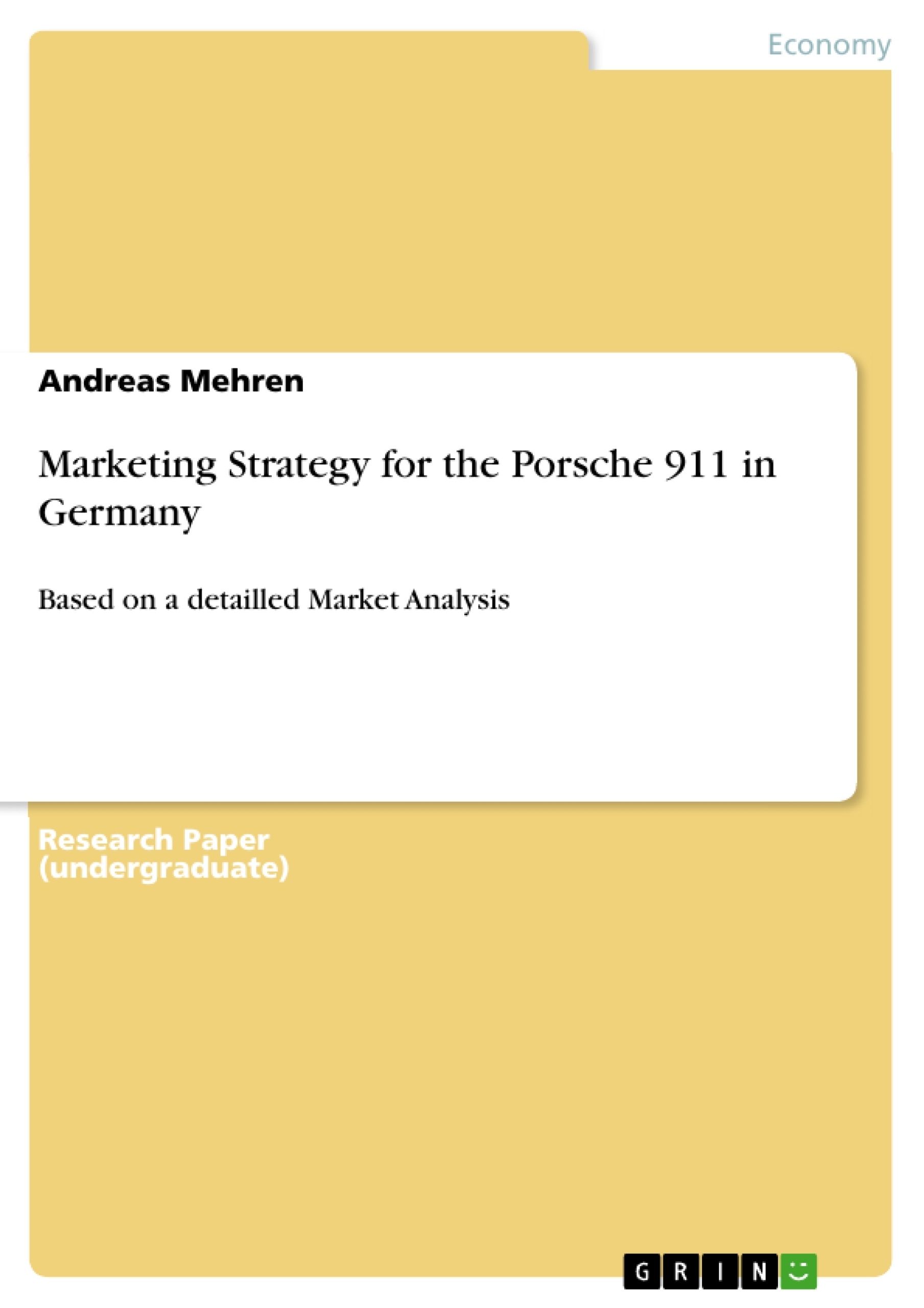Based on a deep dive market analysis done before, this scientific assignment comes from market analysis to strategy definition and development.
This includes the scoping, the target group analysis and definition followed up by the strategy analysis with marketing mix, USP analysis and instruments like the BCG matrix and the product lifecycle analysis. Closed by a conclusion.
The assignment is based on current information on the Porsche marketing strategy as well as own research.
Table of Contents
- Introduction
- Scoping
- Target Group Analysis and Definition
- Strategy Analysis
- USP Unique Selling Proposition
- Portfolio Analysis
- Product Lifecycle Analysis
- Pricing Strategy
- Place / Distribution
- Promotion
- Conclusion
- References
Objectives and Key Themes
The objective of this marketing strategy is to outline a plan to increase sales and maximize turnover for the Porsche 911 Carrera in the German market. The strategy will not include market analysis or implementation details, focusing solely on strategy development.
- Defining the target market for the Porsche 911 Carrera in Germany.
- Developing a unique selling proposition (USP) for the Porsche 911 Carrera.
- Analyzing the product lifecycle of the Porsche 911 Carrera.
- Creating a pricing strategy for the Porsche 911 Carrera.
- Determining the optimal distribution and promotional strategies for the Porsche 911 Carrera.
Chapter Summaries
Introduction: The introduction establishes the importance of a robust marketing strategy for product success, emphasizing the commercialization aspect. It highlights the Porsche 911 Carrera and the German market as the focus of this exemplary marketing strategy development. The chapter outlines the structure of the assignment, starting with scoping and target group analysis, followed by a detailed strategy development, concluding with a summary.
Scoping: This chapter emphasizes the crucial first step in any strategy development: scoping. It defines the parameters of the marketing strategy plan, specifically focusing on the Porsche 911 Carrera as the product, the German car market as the geographical location, and explicitly excluding market analysis and strategy implementation from the scope. It highlights scoping as a dynamic process, requiring review and potential adjustments throughout the project.
Target Group Analysis and Definition: This chapter focuses on identifying the target customer for the Porsche 911 Carrera in Germany. It uses market research and existing Porsche studies from 2003 to define the target group as predominantly wealthy males aged between 40 and 50, with a high emotional connection to cars and driving. The chapter notes that while price is a factor, status, everyday usability and the sporting aspects also play important roles in purchasing decisions, highlighting the emotional and rational elements influencing the buyer.
Keywords
Porsche 911 Carrera, Marketing Strategy, Target Group Analysis, German Car Market, Unique Selling Proposition (USP), Pricing Strategy, Product Lifecycle, Distribution, Promotion, Luxury Cars, Premium Brand, Emotional Branding.
Porsche 911 Carrera German Market Marketing Strategy: Frequently Asked Questions
What is the purpose of this document?
This document outlines a marketing strategy for increasing sales and maximizing turnover of the Porsche 911 Carrera in the German market. It focuses solely on strategy development and excludes market analysis and implementation details.
What are the key themes explored in this marketing strategy?
The key themes include defining the target market, developing a unique selling proposition (USP), analyzing the product lifecycle, creating a pricing strategy, and determining optimal distribution and promotional strategies for the Porsche 911 Carrera in Germany.
Who is the target audience for this marketing strategy?
Based on market research and existing Porsche studies, the target market is predominantly wealthy males aged between 40 and 50, with a strong emotional connection to cars and driving. While price is a factor, status, everyday usability, and sporting aspects also influence purchasing decisions.
What is the scope of this marketing strategy document?
The scope is limited to the development of a marketing strategy for the Porsche 911 Carrera in the German market. Market analysis and implementation details are explicitly excluded. The process is considered dynamic, allowing for adjustments throughout the project.
What are the main chapters covered in the document?
The document includes an introduction, scoping, target group analysis and definition, a detailed strategy analysis (covering USP, portfolio analysis, product lifecycle analysis, pricing strategy, place/distribution, and promotion), a conclusion, and references.
What constitutes the strategy analysis section of the document?
The strategy analysis section delves into defining the unique selling proposition (USP) for the Porsche 911 Carrera, analyzing its portfolio position, examining its product lifecycle stage, establishing a pricing strategy, determining the optimal distribution channels, and outlining promotional strategies.
What are the key takeaways from the chapter summaries?
The introduction emphasizes the importance of a strong marketing strategy for product success. The scoping chapter stresses the importance of defining parameters upfront. The target group analysis highlights the key characteristics of the ideal Porsche 911 Carrera customer in Germany, emphasizing both rational and emotional factors in their purchase decisions.
What keywords are associated with this marketing strategy?
Keywords include: Porsche 911 Carrera, Marketing Strategy, Target Group Analysis, German Car Market, Unique Selling Proposition (USP), Pricing Strategy, Product Lifecycle, Distribution, Promotion, Luxury Cars, Premium Brand, Emotional Branding.
What is the overall objective of this marketing strategy?
The main objective is to create a comprehensive marketing strategy to increase sales and maximize turnover for the Porsche 911 Carrera in the German market.
- Arbeit zitieren
- B.A. Andreas Mehren (Autor:in), 2016, Marketing Strategy for the Porsche 911 in Germany, München, GRIN Verlag, https://www.grin.com/document/340597



